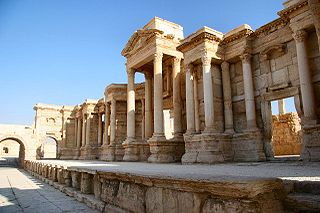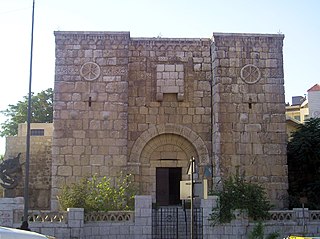Related Research Articles
The 620s decade ran from January 1, 620, to December 31, 629.

The 640s decade ran from January 1, 640, to December 31, 649.

Year 632 (DCXXXII) was a leap year starting on Wednesday of the Julian calendar. The denomination 632 for this year has been used since the early medieval period, when the Anno Domini calendar era became the prevalent method in Europe for naming years.

Year 633 (DCXXXIII) was a common year starting on Friday of the Julian calendar. The denomination 633 for this year has been used since the early medieval period, when the Anno Domini calendar era became the prevalent method in Europe for naming years.

Year 634 (DCXXXIV) was a common year starting on Saturday of the Julian calendar. The denomination 634 for this year has been used since the early medieval period, when the Anno Domini calendar era became the prevalent method in Europe for naming years.

Year 635 (DCXXXV) was a common year starting on Sunday of the Julian calendar. The denomination 635 for this year has been used since the early medieval period, when the Anno Domini calendar era became the prevalent method in Europe for naming years.
Year 636 (DCXXXVI) was a leap year starting on Monday of the Julian calendar. The denomination 636 for this year has been used since the early medieval period, when the Anno Domini calendar era became the prevalent method in Europe for naming years.

Year 637 (DCXXXVII) was a common year starting on Wednesday of the Julian calendar. The denomination 637 for this year has been used since the early medieval period, when the Anno Domini calendar era became the prevalent method in Europe for naming years.

Year 638 (DCXXXVIII) was a common year starting on Thursday of the Julian calendar. The denomination 638 for this year has been used since the early medieval period, when the Anno Domini calendar era became the prevalent method in Europe for naming years.

Year 639 (DCXXXIX) was a common year starting on Friday of the Julian calendar. The denomination 639 for this year has been used since the early medieval period, when the Anno Domini calendar era became the prevalent method in Europe for naming years.

The Battle of the Yarmuk was a major battle between the army of the Byzantine Empire and the Muslim forces of the Rashidun Caliphate. The battle consisted of a series of engagements that lasted for six days in August 636, near the Yarmouk River, along what are now the borders of Syria–Jordan and Syria–Israel, southeast of the Sea of Galilee. The result of the battle was a complete Muslim victory that ended Byzantine rule in Syria. The Battle of the Yarmuk is regarded as one of the most decisive battles in military history, and it marked the first great wave of early Muslim conquests after the death of Prophet Muhammad, heralding the rapid advance of Islam into the then-Christian Levant.

The Muslim conquest of Persia, also known as the Arab conquest of Iran, was carried out by the Rashidun Caliphate from 633 to 654 AD and led to the fall of the Sassanid Empire of Persia as well as the eventual decline of the Zoroastrian religion.
The Battle of River also known as Battle of Al Madhar took place in Mesopotamia (Iraq) between the forces of the Rashidun Caliphate and the Sasanian Empire. Muslims, under Khalid ibn al-Walid's command, defeated the numerically superior Persian army.

The Battle of Walaja was a battle fought in Mesopotamia (Iraq) in May 633 between the Rashidun Caliphate army under Khalid ibn al-Walid and Al-Muthanna ibn Haritha against the Sassanid Empire and its Arab allies. In this battle the Sassanid army is said to have been two times the size of the Muslim army.

The Muslim conquest of the Levant, also known as the Arab conquest of the Levant, occurred in the first half of the 7th century. This was the conquest of the region known as the Levant or Shaam, later to become the Islamic Province of Bilad al-Sham, as part of the Islamic conquests. Arab Muslim forces had appeared on the southern borders even before the death of Muhammad in 632, resulting in the Battle of Mu'tah in 629, but the real conquest began in 634 under his successors, the Rashidun Caliphs Abu Bakr and Umar ibn Khattab, with Khalid ibn al-Walid as their most important military leader.

The Battle of Bosra was fought in 634 between the Rashidun Caliphate army and the Byzantine Empire for the possession of Bosra, in Syria. The city, then capital of the Ghassanid Kingdom, a Byzantine vassal, was the first important one to be captured by the Islamic forces. The siege lasted between June and July 634.
Yazid ibn Abi Sufyan was a leading Arab general at the time of the Islamic conquest of Syria, and the elder brother of Muawiya ibn Abi Sufyan.

The Rashidun Caliphate was the first of the four major caliphates established after the death of the Islamic prophet Muhammad. It was ruled by the first four successive caliphs (successors) of Muhammad after his death in 632 CE. These caliphs are collectively known in Sunni Islam as the Rashidun, or "Rightly Guided" caliphs.

The siege of Damascus (634) lasted from 21 August to 19 September 634 before the city fell to the Rashidun Caliphate. Damascus was the first major city of the Eastern Roman Empire to fall in the Muslim conquest of Syria.
The Rashidun army was the core of the Rashidun Caliphate's armed forces during the early Muslim conquests in the 7th century. The army is reported to have maintained a high level of discipline, strategic prowess and organization, granting them successive victories in their various campaigns.
References
- ↑ Whitby, Michael (2002). Rome at War AD 293–696. London: Osprey. p. 76. ISBN 1-84176-359-4.
- ↑ Nicolle 1994, p. 62.
- ↑ Yorke, Barbara (2003). Nunneries and the Anglo-Saxon Royal Houses. London: Continuum. p. 23. ISBN 0-8264-6040-2.
- ↑ Pourshariati, Parvaneh (2008). Decline and Fall of the Sassanid Empire. London: I.B. Tauris. pp. 181–183. ISBN 978-1-84511-645-3.
- ↑ Muir, William (1861). The Life of Mahomet and the History of Islam. 4. London: Smith, Elder. p. 145.
- ↑ Kronika tzv. Fredegara scholastika
- ↑ Nominalia of the Bulgarian khans
- ↑ Espenak, F. "NASA - Solar Eclipses of History". eclipse.gsfc.nasa.gov.
- ↑ "List of Rulers of Korea". www.metmuseum.org. Retrieved 21 April 2019.
- ↑ Guidoboni, Emanuela; Traina, Giusto (1995). "A new catalogue of earthquakes in the historical Armenian area from antiquity to the 12th century". Annals of Geophysics. 38 (1).
- 1 2 Bede Book III, Chapter I.
- ↑ Roberts, J: "History of the World." Penguin, 1994
- ↑ Campaigns in Eastern Iraq, "Khalifa Abu Bakr", Companion of the Prophet. Virtual library of Witness-Pioneer.
- ↑ al-Tabari Vol. 2, p. 562.
- ↑ The Caliphate, Its Rise, Decline, and Fall. From Original Sourcesby William Muir, p. 56
- ↑ Annals of the Early Caliphate by William Muir, p. 85
- ↑ Thompson, E. A. (1969) "The Goths in Spain". Oxford: Clarendon Press
- ↑ Bede Book II, Chapter XX.
- ↑ Richard Nelson Frye, The Cambridge History of Iran: The periode from the Arab invasion to the Saljuqs, p. 9. Cambridge University Press (1975)
- ↑ Akram 1969.
- ↑ Walter E. Kaegi, Byzantium and the Early Islamic Conquests. Cambridge University Press (1992)
- ↑ Akram 1970, p. 576.
- ↑ Blankinship, 1993, p. 110
- ↑ Akram 1970.
- ↑ Milan 2009, p. 155
- ↑ Coles, R.J. (1981). Southampton's Historic Buildings. City of Southampton Society, p. 6
- ↑ A Brief History of St. Mary's Church. Retrieved 30 October 2009
- ↑ Smith, Julia M. H. (1992). Province and Empire: Brittany and the Carolingians. Cambridge University Press. pp. 19, 21. ISBN 978-0-521-03030-4.
- ↑ Al-Waqidi & 8th century, p. 100
- ↑ Nicolle 1994, p. 44.
- ↑ Nicolle 2009, p. 51.
- ↑ Nicolle 1994, p. 43.
- ↑ Nafziger, George F.; Walton, Mark W. (2003). Islam at War. Westport, CT: Greenwood Publishing. p. 30. ISBN 0-275-98101-0.
- ↑ Nicolle 1994, pp. 6, 19.
- ↑ Kirby 2000, p. 51.
- ↑ Rosenthal, p. 12
- ↑ Akram 2004, p. 431
- 1 2 Nicolle 2009, p. 52.
- ↑ Geography at about.com
- ↑ Al-Maqrizi, Mawaiz wa al-'i'tibar bi dhikr al-khitat wa al-'athar
- ↑ Alfred Butler, "The Invasion of Egypt", p. 213
- ↑ Saint Quen of Rouen; trans. Jo Ann McNamara. "The life of Saint Eligius" (Vita Sanci Eligii)
Sources
- Akram, Agha Ibrahim The Sword of Allah:
- Akram, A. I. (1969). "The Sword of Allah: Khalid bin al-Waleed, His Life and Campaigns". Lahore: Feroze Sons. Archived from the original on February 24, 2002. Retrieved June 8, 2013.
- Akram, Agha Ibrahim (1970). The Sword of Allah: Khalid bin al-Waleed, His Life and Campaigns. Rawalpindi: National Publishing House. ISBN 978-07101-0104-4.
- Akram, Agha Ibrahim (2004). The Sword of Allah: Khalid bin al-Waleed – His Life and Campaigns. Oxford University Press. ISBN 978-0-19-597714-1.
- Bede. "Book II". Ecclesiastical History of the English People . Internet History Sourcebooks Project.
- Bede. "Book III". Ecclesiastical History of the English People . Internet History Sourcebooks Project.
- Kirby, D. P. (2000). The Earliest English Kings (revised ed.). Routledge. ISBN 0-415-24211-8.
- Nicolle, David (1994). Yarmuk 636 AD: The Muslim conquest of Syria. London: Osprey. p. 62. ISBN 1-85532-414-8.
- Nicolle, David (2009). The Great Islamic Conquests AD 632–750. p. 52. ISBN 978-1-84603-273-8.
- al-Tabari. History of the Prophets and Kings . 2.[ full citation needed ]